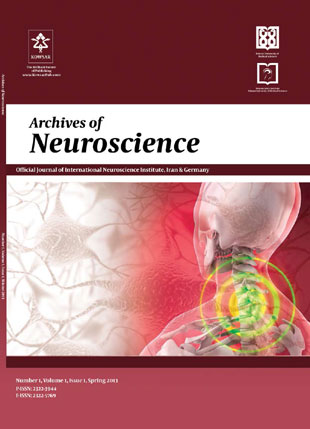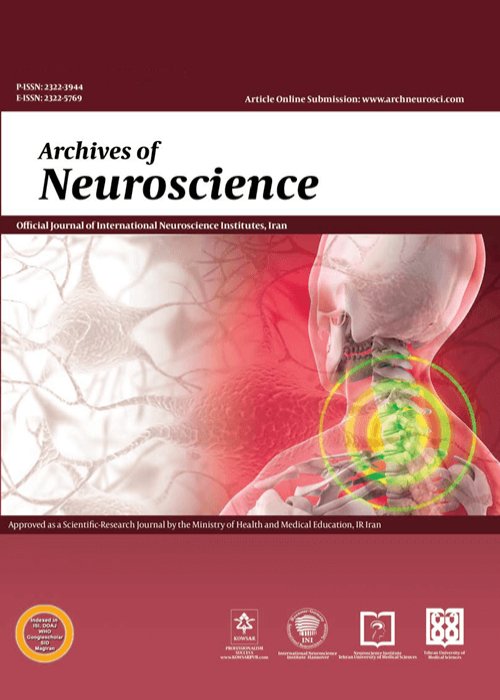فهرست مطالب

Archives of Neuroscience
Volume:1 Issue: 1, Apr 2013
- تاریخ انتشار: 1392/07/03
- تعداد عناوین: 8
-
-
Pages 3-6Context: Clinical research is an interdisciplinary project which has been given a high priority by health organizations. Because of its complexity and importance, most of health system authorities have supported the using of project management knowledge and skills in performance of health and clinical researches..Evidence Acquisition: Establishing portfolio management within a project management office can help investigators with the performance of their research projects and increasing efficiency of research projects by centralizing and consolidating..ResultsPMO and its counterparts for instance, clinical trial office and office for good clinical practice can play an important role in the best performance of clinical and health research projects..ConclusionsIn this study we will describe the crucial role of project management and also project management office in clinical research projects..Keywords: Clinical Protocols, Knowledge, Research
-
Pages 7-14Context: Recently, stem cell research has gained great public interest and different cell-based clinical trials have started in Iran. The objective of this study was to provide an overview of clinical cell transplantation researches in Iran, which has assumed a leadership role in the Middle East.. Evidence Acquisitions: To evaluate the state of clinical cell transplantation researches in Iran, we conducted a literature review on December 1, 2011 using PubMed, IranMedex, US NIH registry for clinical trials and Iranian registry of clinical trials (IRCT). We used “Cell”, “Cells”, “Cell Transplantation”, and «Iran” as keywords to identify stem cell related research articles or projects. Publications were then examined manually to exclude those that did not use stem cells in a clinical setting or did not report original research. Hard copy of all related articles were used to extract the following data: the year of publication, journal’s name, number of authors, cell type, processing method, subject, and study design..ResultsTwenty one articles and 33 registered trials were related to clinical application of cellular products. Except for 6 articles, the others were multicenteral. The main subject of articles was cardiovascular diseases (23. 52%) and for registered clinical trials this was osteoarticular disorders (24. 24%). Bone marrow derived mesenchymal stem cells (BM-MSC) and mononuclear cells (BM-MNC) were the most frequent cell types in these trials. From 12 completed trials only 4 have been reported in medical journals..ConclusionsBy comparison with basic stem cell research, the current status of cell transplantation trials in Iran is not optimal. Joined multicenteral research, establishment of national regulations, sharing of facility and staff, international collaborations and bridging the gap between basic and clinical research may improve quality and quantity of clinical cell transplantation research in Iran.Keywords: Clinical Trial, Stem Cells, Therapy, Transplantation
-
Pages 15-20Context: The nervous system is the most important system of the body and damaging this system could be lethal for humans. Restoring the function of a damaged nervous system has always been a challenge due to the complexity of this system and its limited ability of regeneration. Furthermore, several obstacles exist in the repair process of the nervous system..Evidence Acquisitions: In the central nervous system (CNS) limited clearance of myelin and formation of inhibitory glial scars make regeneration difficult. There is no effective clinical treatment for damages in the CNS while current treatments focus on stabilization and prevention of further damage and consequently on rehabilitation and preparation of prosthetics and mechanical aids. In peripheral nervous system (PNS) damages, the management may be a nerve autograft or allograft while shortage of donors for nerves makes the situation difficult. Size inequality between the donor nerve and the recipient, danger of neuroma formation and occurrence of infectious diseases are other problems associated with PNS, while indeed complete recovery of function is still not common..ResultsSeveral studies have illustrated that implying tissue engineering strategies for neural repair may lead to considerable improvements in damaged nervous tissues. The development of a scaffold that is similar to the natural extracellular matrix can provide an ideal environment for three dimensional cell cultures, which is a reason for neural tissue engineering success. The need to develop biocompatible and biodegradable material that supports neural tissue growth still exists..ConclusionsThis article reviews different types of polymeric materials used in neural tissue engineering and mainly focuses on their properties and their advantages and disadvantages in neural regeneration..Keywords: Polymers, Tissue Engineering, Nervous System
-
Neurological Manifestations as Presenting Feature of Osteopetrosis in Children; A Review of 11 CasesPages 21-25BackgroundOsteopetrosis is a rare congenital disorder characterized by the malfunction of osteoclast cells resulting in increased bone density and adverse complications such as bone marrow insufficiency, bone fragility, and neurological symptoms subsequent to increased cortical thickness of the skull..ObjectivesWe studied neurologic manifestation of the disease, the main complaints that resulted in the diagnosis, the management and outcome during the follow up period..Patients andMethodsThis study comprised of children having neurological symptoms as their initial presentation of osteopetrosis that were referred to Children Medical Center Hospital in Tehran from June 2001 to 2011..ResultsIntracranial hypertension was the first presentation of osteopetrosis in 11 of the children; 7 patients showed signs and symptoms of hydrocephalous, and 4 had pseudotumor cerebri. In addition, visual disturbance was also a common finding. All patients aged 2 or more (5 children) complained of headache, and 2 of the patients (18%) had facial palsy. During the follow-up (2.1 ± 1.9 years), 3 patients (27%) died due to bone marrow insufficiency and sepsis..ConclusionThe diagnosis of osteopetrosis with the aid of neurological presentation is uncommon and neurological complications are usually found during the follow-ups. All of our patients presented with signs and symptoms of intracranial hypertension and the diagnosis of osteopetrosis was established. After a trail of investigations, this observation considers the importance of extensive evaluation of a child with a new onset hydrocephalus to prevent further serious complications..Keywords: Hydrocephalus, Osteopetrosis, Pseudotumor Cerebri
-
Pages 26-30BackgroundTrans-pedicular screw placements have been an increasingly popular procedure in many neurosurgery and orthopedic departments. Any mistake at performing the technique could be followed by irreversible neurological deficit and damage of Para spinal vital structures as well as less stability for future fusion..ObjectivesIn this study we tried to show the benefits and capabilities of a new device, Transpedicular Screw Insertion Guidance Device (TSIGD) for best possible correct transpedicular screw placement..Patients andMethodsThis study is a quasi-experimental study performed in 2010 in Isfahan at Al-Zahra General hospital. The study was based on the application of a new device, which is named Transpedicular Screw Insertion Guidance Device (TSIGD) that leads the neurosurgeon to find the Proper Pedicular Angle (PPA)..Results10 patients were enrolled in this study, all of them with the waiver of consent. A total of 54 screws were assigned to evaluate the capability of the TSIGD for correct screw placement by PPA (Proper Pedicular angle) and SA (Screw Angle). Only 2 screws (5.5%) were identified as medial pedicular breach on postoperative CT scans without any neurological deficit. The mean Proper Pedicular Angle (PPA) was 26.15 (± 0.4) that was calculated based on axial CT scan performed before the operation and mean screw angel (SA) that was calculated based on axial CT scan after the operation was 25.79 (± 0.8), (P ≥ 0.05)..ConclusionsNot only this method is less expensive for the patients but it also saves time during surgery in contrast to CT based surgery. Also, this device is useful for neurosurgical assistants and young surgeons to reduce misplacement of pedicular screw..Keywords: Insertion, Device, Pilot Projects
-
Pages 31-34BackgroundExposure to solvents is a common event in industrial factories, and has numerous acute and chronic neuro-behavioral effects on workers..ObjectiveIn this study, we tried to evaluate the effects of long time exposure to solvents on the mood alteration of workers in a tire factory..Patients andMethodsIn this cross sectional study, we selected 90 men who were exposed to solvents in a tire factory and compared their behavior-mood test (POMS) with 70 people in a control group who had no exposure to solvents. This questionnaire consisted of 64 words that described the individual''s emotions. Each person selected one of the five levels for stating emotions (from 0 = never to 4 = very much). A positive score from 0 to 4 belonged to each item, and the total score was the sum of all scores. First, demographic information was collected in a questionnaire. Then, we used another questionnaire with 16 questions for detecting neuro-behavioral disorders due to continuous exposure to solvents in both groups..ResultsThere was no statistically significant difference between the two groups based on age and educational level (P > 0.05). The mean of employment duration in the exposed group was significantly longer than the control group (P < 0.05). The results of comparing the two groups in six mood levels showed no statistically significant difference (P > 0.05)..ConclusionAccording to our results, the Q16 questionnaire is recommended as a screening tool in periodic examinations of workers exposed to solvents. Questionnaire evaluations are used to help determine whether long-term overexposure to solvents has affected the central nervous system (brain)..Keywords: Rubbers Solvent, Affect, Occupational Exposures
-
Pages 35-40BackgroundBehavioral studies on animals demonstrated that hippocampal damage could produce learning and memory impairments particularly spatial learning. It has been shown that ischemic damage restricted to only 50% of the CA1 cells of the hippocampus exceed the threshold for production of a behavioral impairment..ObjectivesIn this study we seek to evaluate the effect of FK506 (tacrolimus) on spatial learning of rats subjected to 20-min global transient ischemia/reperfusion..Material And MethodsIn experimental group1, FK506 (1mg/kg) was given intravenously (IV) 20 minutes before ischemia and in experimental group2 rats were treated with the same dose of tacrolimus (IV) at the beginning of reperfusion. Morris water maze tests were performed 1 week after ischemia for 4 days. Brain tissue proceeded to TUNEL staining..ResultsOur data showed; 1) No statistically significant differences were seen between the experimental group1 and the control (intact) group thus, this suggests that treatment of ischemia with tacrolimus can improve spatial learning and memory. 2) Tacrolimus treatment ameliorated the increase of TUNEL–positive cells induced by cerebral ischemia indicating the neuro-protective properties of FK506..ConclusionsThese results suggest that tacrolimus may reduce cognitive impairment and may be a good candidate for treatment of ischemic brain damage..Keywords: Neuroprotective Agents, Spatial Memory Disorders, Maze


